
We Care a Lot Part 24: The Antihero’s Journey Concludes
July 9th, 2011 by Gavok | Tags: anti-venom, eddie brock, spider-man, symbiotes, venom, we care a lotIt’s so weird to see this article come full circle. As I said long ago in the prologue, We Care a Lot gained its genesis in a series of posts in a forum that no longer exists. David Brothers was new to blogging and asked me to join him many years ago, citing that I’d be able to repost my Venom essays, finish them and write junk like it. I may have done that latter part, but I never could get back into writing about Venom. At the time, the character I once loved and saw things in that few else ever did had become a dummy used in various stories that for the most part weren’t very good. Unlike the “weren’t very good” stories from the 90’s, these stories actually went and destroyed my interest in him.
Look how far everything’s come since then. As Venom, Mac Gargan became a major star in the Marvel Universe for quite a while, got his own miniseries and was a wheel in one of Marvel’s top selling books at the time. Now Venom is worn by Flash Thompson and stars in his own comic that has definite staying power (I was going to say that it has legs, but, well…). Eddie Brock has been reborn in a new form with appearances in Spider-Man’s main comic here and there, as well as an upcoming Venom crossover. Carnage has come back from the afterlife with a couple miniseries that make the character kind of sort of worth reading. Not only did his return give us yet another symbiote hero character who will fall off the face of the Earth, but a preview of Carnage USA suggested that there’d be some kind of task force made of obscure symbiote characters only remembered by me, the people who’ve read these articles and maybe six other people. I can only hope.
The whole Venom Family is thriving and comics have evolved in the way that modern writers have a better grasp on what to do with these guys. I’ve seen a lot of criticism on Dan Slott’s Amazing Spider-Man, but I can’t fault him on his use of Anti-Venom. The dude just plain gets it. Or he at least gets what I get.
I suppose with Venom, my enjoyment of the character has been almost defining for me. I know some people online might consider me “the Venom guy”, for better or worse. I never set out to make readers fully agree with my delight with the character/concept, but I at least wanted to make them understand where I was coming from. I hope that I’ve at least succeeded in that.
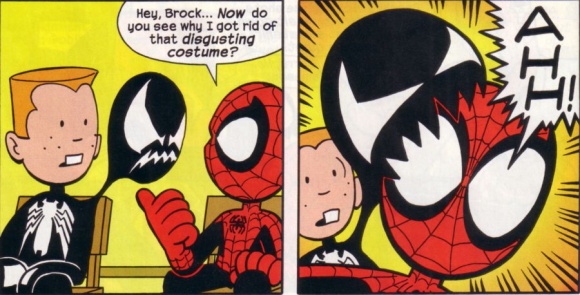
He’s a Silver Age concept painted with a 90’s extreme paintbrush. Look at the whole symbiote idea. Tell me that that isn’t a Silver Age idea that nobody got around to using until they were decades too late. It’s a plot device that writers continue to pull new tricks out of their asses for (might I remind you that symbiotes can kill people through the internet?). Yet in the end, it’s Eddie Brock who anchors it all. I’m not one of those fanboys who wants him to be Venom again because, “That’s the only way it can be.” No. I’d rather he be Anti-Venom forever.
When done right, Eddie is someone that writers have yet to scratch the surface of. He isn’t like the Punisher. He may kill and justify it, but he isn’t dead inside. In fact, he’s more optimistic about what he does than most superheroes in their saner exploits. He thinks he’s right and sometimes he is, but he’s occasionally capable of understanding that he’s wrong and can indeed agree with logic every once and a while.
Over the years, Venom has been treated like the redheaded stepchild of Marvel. Tossed around from writer to writer and making appearances that treat him as more of a money-making accessory than an actual character. He’s been in some good stories, he’s been in a lot of bad stories and he’s been in a few incredibly terrible stories. I recognize that. I’m not blind.
I also recognize something else.
Over the last 25 years, Marvel’s chaotic use of Venom has led to something somewhat majestic. By putting together the history of Eddie Brock appearances, told by dozens upon dozens of writers, they end up swirling together into the Hero’s Journey. The Hero’s Journey, or Monomyth, is a list of guidelines pointed out by Joseph Campbell that explain the archetypical steps of a hero’s story. Just about every single superhero movie goes by this pattern, but it’s not always easy to come by in comic form. After all, a lot of the major Marvel heroes made their major character changes in their first appearances and since then have been going through endless adventures and playing off other characters while staying mostly the same. For Eddie, it started from Web of Spider-Man #18, where he tried to shove Peter into a subway train and ended in the extremely recent Amazing Spider-Man #664.
The entire archetype guide is best explained through these two links, but I think I’ll copy and paste from the latter, since it’s a bit easier to understand. Though I changed the random “she”s to “he”s because, you know, our subject is a dude.
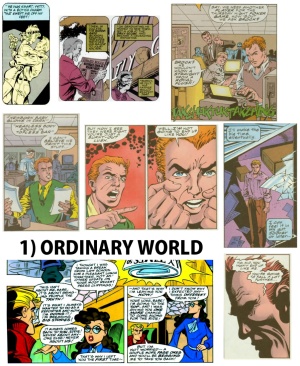
1) ORDINARY WORLD
Most stories take the hero out of the ordinary, mundane world and into a Special World, new and alien. This is the familiar “fish out of water” idea which has spawned countless films and TV shows.
If you’re going to show a fish out of his customary element, you first have to show him in that Ordinary World to create a vivid contrast with the strange new world he is about to enter.
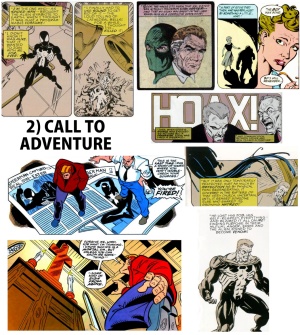
2) CALL TO ADVENTURE
The hero is presented with a problem, challenge, or adventure to undertake. Once presented with a Call to Adventure, he can no longer remain indefinitely in the comfort of the Ordinary World.
The Call to Adventure establishes the stakes of the game, and makes clear the hero’s goal: to win the treasure or the lover, to get revenge or right a wrong, to achieve a dream, confront a challenge, or change a life.
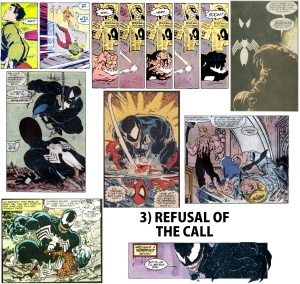
3) REFUSAL OF THE CALL
This one is about fear. Often at this point the hero balks at the threshold of adventure, Refusing the Call or expressing reluctance. After all, he is facing the greatest of all fears, terror of the unknown. The hero has not fully committed to the journey and may still be thinking of turning back. Some other influence – a change in circumstances, a further offense against the natural order of things, or the encouragement of a Mentor – is required to get him past this turning point of fear.
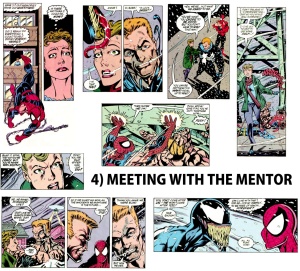
4) MEETING WITH THE MENTOR
By this time many stories will have introduced a Merlin-like character who is the hero’s Mentor. The relationship between hero and Mentor is one of the most common themes in mythology, and one of the richest in its symbolic value. It stands for the bond between parent and child, teacher and student, doctor and patient, god and man.
The function of Mentors is to prepare the hero to face the unknown. They may give advice, guidance or magical equipment.
However the Mentor can only go so far with the hero. Eventually the hero must face the unknown alone. Sometimes the Mentor is required to give the hero a swift kick in the pants to get the adventure going.
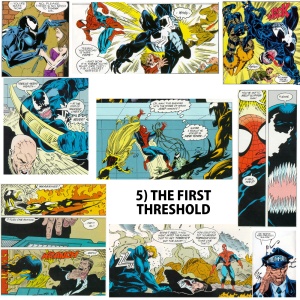
5) THE FIRST THRESHOLD
Now the hero finally commits to the adventure and fully enters the Special World of the story for the first time by crossing the First Threshold. He agrees to face the consequences of dealing with the problem or challenge posed in the Call to Adventure. This is the moment when the story takes off and the adventure really gets going. The balloon goes up, the ship sails, the romance begins, the plane or the spaceship soars off, the wagon train gets rolling, etc.
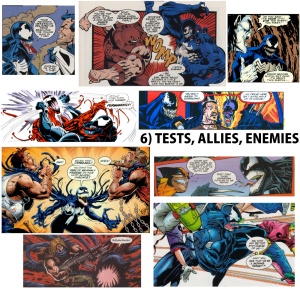
6) TESTS, ALLIES, ENEMIES
Once across the First Threshold, the hero naturally encounters new challenges and Tests, makes Allies and Enemies, and begins to learn the rules of the Special World.
Saloons and seedy bars seem to be good places for these transactions. Countless Westerns take the hero to a saloon where his manhood and determination are tested.
Scenes like these allow for character development as we watch the hero and his companions react under stress.
Of course not all tests, alliances, and enmities are confronted in bars. In many stories, these are simply encounters on the road.
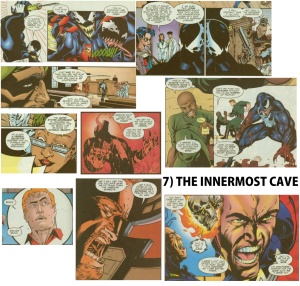
7) THE INNERMOST CAVE
The hero comes at last to the edge of a dangerous place, sometimes deep underground, where the object of the quest is hidden. Often it’s the headquarters of the hero’s greatest enemy, the most dangerous spot in the Special World, the Innermost Cave. When the hero enters that fearful place he will cross the second major threshold. Heroes often pause at the gate to prepare, plan, and outwit the villain’s guards. This is the phase of the Approach.
Approach covers all the preparations for entering the Innermost Cave and confronting death or supreme danger.
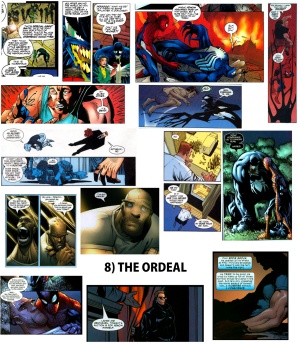
8) THE ORDEAL
Here the fortunes of the hero hit bottom in a direct confrontation with his greatest fear. He faces the possibility of death and is brought to the brink in a battle with a hostile force. The Ordeal is a “black moment” for the audience, as we are held in suspense and tension, not knowing if he will live or die.
This is a critical moment in any story, an Ordeal in which the hero must die or appear to die so that she can be born again. It’s a major source of the magic of the heroic myth. The experience of the preceding stages has led us, the audience, to identify with the hero and her fate. What happens to the hero happens to us. We are encouraged to experience the brink-of-death moment with him. Our emotions are temporarily depressed so that they can be revived by the hero’s return from death. The result of this revival is a feeling of elation and exhilaration.
Every story needs such life-or-death moment in which the hero or his goals are in moral jeopardy.
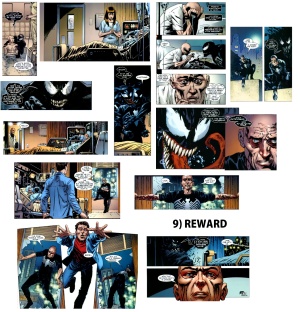
9) REWARD
Having survived death, beaten the dragon, or slain the Minotaur, hero and audience have cause to celebrate. The hero now takes possession of the treasure he has come seeking, his Reward. It might be a special weapon like a magic sword, or a token like the Grail or some elixir which can heal the wounded land.
Sometimes the “sword” is knowledge and experience that leads to greater understanding and reconciliation with hostile forces.
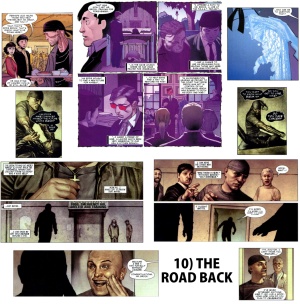
10) THE ROAD BACK
The hero’s not out of the woods yet. We’re crossing into Act Three now as the hero begins to deal with the consequences of confronting the dark forces of the Ordeal. If he has not yet managed to reconcile with the parent, the gods, or the hostile forces, they may come raging after him. Some of the best chase scenes spring up at this point, as the hero is pursued on the Road Back by the vengeful forces he has disturbed by seizing the sword, the elixir or the treasure.
This stage marks the decision to return to the Ordinary World. The hero realizes that the Special World must eventually be left behind, and there are still dangers, temptations, and tests ahead.
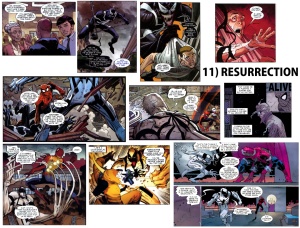
11) RESURRECTION
In ancient times, hunters and warriors had to be purified before they returned to their communities, because they had blood on their hands. The hero who has been to the realm of the dead must be reborn and cleansed in one last Ordeal of death and Resurrection before returning to the Ordinary World of the living.
This is often a second life-and-death moment, almost a replay of the death and rebirth of the first Ordeal. Death and darkness get in one last, desperate shot before being finally defeated. It’s a kind of final exam for the hero, who must be tested once more to see if he has really learned the lessons of the first Ordeal.
The hero is transformed by these moments of death-and-rebirth, and is able to return to ordinary life reborn as a new being.
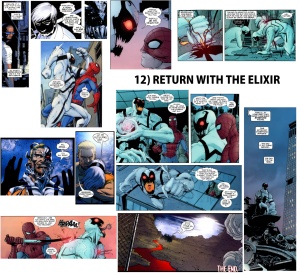
12) RETURN WITH THE ELIXIR
The hero Returns to the Ordinary World, but the journey is meaningless unless he brings back some Elixir, treasure, or lesson from the Special World. The Elixir is a magic potion with the power to heal. It may be a great treasure like the Grail that magically heals the wounded land, or it simply might be knowledge or experience that could be useful; to the community someday.
Sometimes the elixir is treasure won on the quest, but it may be love, freedom, wisdom, or the knowledge that the Special World exists and can be survived.
And that’s that.
It’s like comic book version of watching Wizard of Oz while listening to Pink Floyd.
I’m not going to be completely glib about this. Anti-Venom won’t last. He’ll fall into obscurity and one day Eddie Brock will be back to wearing the black costume while cursing Spider-Man’s name. Stupid shit will happen that I can’t even imagine.
But unlike my younger self when I started writing in the beginning, all those years ago, I feel a sense of closure. I cared a lot and it paid off.
Thanks for reading. It’s been a blast.
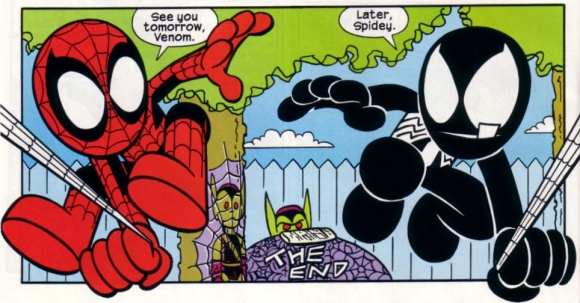

I’m sad to see this series go but the Hero’s Journey comparison was really masterful and is a perfect ending. I’d like to see Anti-Venom go on forever because it’s as close to a happy ending as we’ll ever get for poor Eddie, but you’re right in that he’ll more than likely eventually end up in the black suit again.
Anyway, thanks for caring. A lot.
What’s the word on how Venom proper has been acting with Flash so far, anyways? They still decided that the symbiote is irredeemably nasty? I think I’ve always liked Brock and the suit best when neither of them was labelled “the problem,” just the sum of their screwed-up personalities being worse than the whole of their parts, and Venom-the-alien seems to have sort of been left holding the villain bag for the past few years, as best as I can tell.
@Matt Cruea: Thank you.
@Drakyn: The costume is one part “violent and impulsive monster” and one part “loyal dog” at the moment. It appears to have taken a liking to Flash and will give him some leeway, but in times of agitation, it’ll go completely bonkers against Flash’s will. Once it settles down, it tends to give him full control out of shame because it recognizes that it went too far, like trying to kill Spider-Man instead of saving Betty from a bomb.
Reminds me of that Final Crisis tie-in at the end of Morrison’s Batman run, where he flashes through Batman’s whole history from start to present. Great conclusion to a great series!
As a bonus, with Venom moving on from Eddie and jumping to first Mac and now Flash means that the symbiote is finally living up to one of the original concepts behind the character, the part where it was meant to have a rotating series of hosts. At least, if I remember my behind the scenes material correctly, that is.
You made me care, Gavok. This last post was legendary.
@Gavok: Nice job, Gavok. There’s more thought and heart put into this series than a lot of the Venom comics I’ve read over the years.
Congratulations. You’ve about written the book on Venom – literally.
A great ending to a great series of thought-provoking articles. Your “We Care a Lot” articles have consistently been some of my favourites over the few years I’ve been reading 4th letter. Good on ya!
Great stuff, great conclusion.
I’m really sad to see this series go. I do however, love that as it ends, Venom’s status quo is back to being awesome. 🙂
@Gavok: A very late, god-damn-my-lazy-ass-is-overworked thank-you for that info. Eddie’s cool, but I’ve got a soft spot for anything nonhumanoid, and it’s nice to hear they’re toning down the “IT’S GONNA EATCHER BRAAAAAAINS” angle. For something that originally came to earth just to get an adrenaline rush, then was shot and sealed in a big tube, it’s sometimes sad to see how little sympathy and how much crazy it gets assigned by writers.
Beautiful work man. I too am sad to see this series go, but it’s as close to a perfect ending as we can get. I’ve been reading your WCAL entries for some time now and this was amazingly handled. When I picked up ASM 664 and I saw that final panel with Eddie, my heart swelled a bit. It was beautiful, meaningful and it was a crowing achievement of progression. Ever since the backup in New Ways to Die (where he finds himself cured of the Big C), I’ve dreaded Brock being a villain again; he was given a new lease on life and was growing as a character, a human being. So when AV showed up and actually forgave Pete and was caring for Jenna, I was giddy beyond belief.
Some people felt it was Lethal Protector round 2, but I saw something different. I can only hope that things get better from here for Brock. I fear the inevitable return to him being possessed by a singular focus of revenge again. Though interestingly, it seems he’s being prepared for greatness or at least a rather good run:
1.) His first appearance in a non-comic book form of media is coming with Edge of Time. This is a rather high profile game that could have “played it safe” and use the incarnation that the general audience is aware of, but instead chose the newer and to some fans, controversial version. I think depending on his portrayal, this could be a rather nice boost for Brock. Though my fear is that that could lead to more appearances and the same 90s derailment. Though I’m trying to be optimistic.
2.) His post ASM # 664 appearances seem to hold some weight for his future. He seems like he’ll be a bit player in Spider Island, and looking at interviews with Remender on Brock and Flash’s relationship, it seems that this wont be the only time we’ll see them interact. I could be wrong, but I strongly feel that he’ll grow some more and become like an on again off again mentor for Flash and help him on a journey of his own. From hapless bully, to War hero, to Super hero. There’s a lot of potential here and I think that done right, it could actually build Brock into such a good direction that the inevitable fall, will take longer and have a smaller blow to what has been built up.
Sorry for the long post, I just get passionate about writing on Brock and Deadpool heh.
All the best Gavok, thanks for a great series!